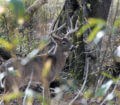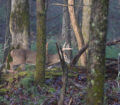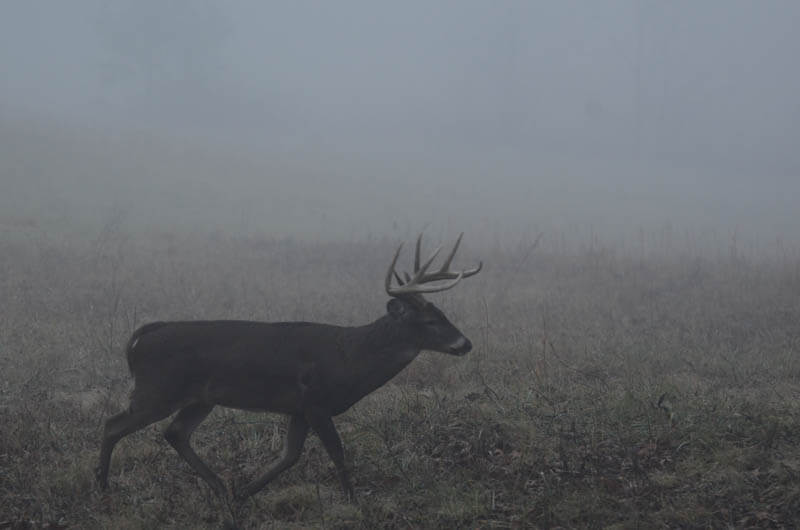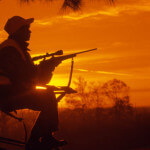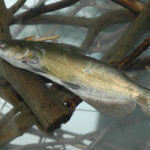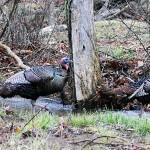John’s Note: Rain, sleet, snow or hail will keep most blackpowder hunters at home and from hunting deer. On the days the weatherman predicts wet weather, I know the lands I hunt will have less hunting pressure from any hunters, particularly from blackpowder hunters. I’ll also have better odds of seeing a deer. During bad weather, I do lose my ability to hear deer walking in the woods, crunching acorns, sparring or grunting – some of the best ways to find deer on still, calm days. I also lose some vision because during rain or snow I usually can’t detect a deer’s tail or ear twitch. However, on rainy days, deer can’t hear, see or even smell as well as I can. Rain provides the best conditions for me to stalk. Deer rarely like to move in the rain. Although I hunt in the rain, I usually hope the rain will stop at some time during the day. When the rain quits, even if only for 30 to 45 minutes, I know the deer generally will move then.
One day some years ago, I watched the raindrops fall off the bill of my hunting cap as loud splashes and a chorus of quacking interrupted the whistling wings of waterfowl. Wood ducks and mallards had poured into the slough before first light to feed on acorns floating on the surface. On this rainy morning, I knew I could forget about hearing a deer walking through the woods. Even without the sound of the rain, the raucous quacking would have drowned out the sounds of any approaching whitetails.
As I watched the ducks to my right, I saw a blob on the edge of the water I hadn’t spotted earlier. A large dark shadow jutted out from the base of a massive swamp chestnut tree. I identified the parallel line about 3 feet off the ground as a deer’s back. I used my binoculars to look through the rain to see the deer more clearly. Since the animal had its back to me, I couldn’t identify its sex.
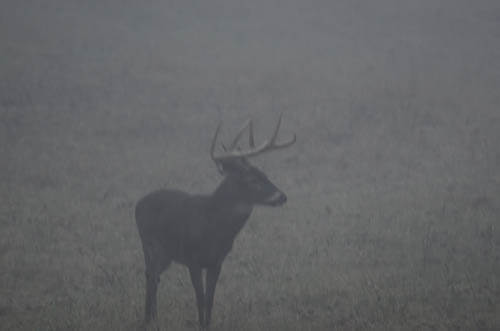 I continued to watch and wait, until the deer turned and quartered to me. Finally, I saw the deer’s 6-point rack. I eased the binoculars down to my chest and picked up my Connecticut Valley Arms (CVA) blackpowder rifle (www.cva.com). I cocked the hammer but didn’t remove the hard plastic nipple protector I’d placed over the nipple before I’d left camp that morning. Regardless of how many precautions you take, when you hunt with black powder in the rain, you always wonder whether your powder and your cap have remained dry, and if you will get ignition when you touch the trigger.
I continued to watch and wait, until the deer turned and quartered to me. Finally, I saw the deer’s 6-point rack. I eased the binoculars down to my chest and picked up my Connecticut Valley Arms (CVA) blackpowder rifle (www.cva.com). I cocked the hammer but didn’t remove the hard plastic nipple protector I’d placed over the nipple before I’d left camp that morning. Regardless of how many precautions you take, when you hunt with black powder in the rain, you always wonder whether your powder and your cap have remained dry, and if you will get ignition when you touch the trigger.
The buck stood about 60-yards away. I thought I probably could make this shot with my iron sights. But because I wanted to see what the buck would do, I watched him for about 15 minutes. Then he slowly turned toward me and walked along the edge of flooded timber, scooping up acorns on the water’s surface as he came closer to me.
When I had scouted this area earlier in the season and found this swamp chestnut tree, I knew the deer in this section of hunting land would feed on it. However, I also saw that this particular draw had white oak acorns and red oak acorns on the ground. Since this low spot in the woods always flooded after the first heavy rain in the fall, I knew from past history the acorns would float along the edges of the water.
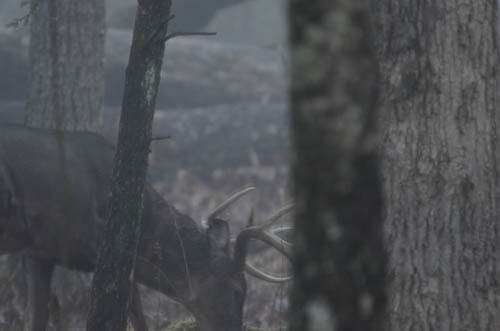 Two primary deer-food sources – the acorns floating at the edges of the flooded timber and the swamp chestnut tree on the bank – intersected there like two banquet tables for a starving man with meat, potatoes, vegetables, biscuits and gravy on one side and all the desserts you could imagine on the other side. At this site, the deer only had to turn from one side to the other to choose what they preferred to eat.
Two primary deer-food sources – the acorns floating at the edges of the flooded timber and the swamp chestnut tree on the bank – intersected there like two banquet tables for a starving man with meat, potatoes, vegetables, biscuits and gravy on one side and all the desserts you could imagine on the other side. At this site, the deer only had to turn from one side to the other to choose what they preferred to eat.
Although many hunters think that only two different types of terrain form a funnel by squeezing down together and leaving a small passageway for the deer, food sources like those I identified also can create funnels. Deer generally will eat acorns along the edges of flooded timber. They also will travel great distances to feed on the preferred acorns of the swamp chestnut. Anytime you can find an intersection of two choice food sources, you’ll have a perfect spot to take a buck with your blackpowder rifle.
My plan worked. After the buck fed heavily on the white oak acorns, he moved down the edge of the flooded timber toward my stand site. He watched the ducks and never demonstrated an alarmed posture. When he stood 40 yards from my tree stand, I eased off the nipple protector, laid my cheek against the stock, prayed the powder would ignite and squeezed the trigger. At the report of my CVA blackpowder rifle, the buck whirled, ran about 20 yards, stumbled and fell. As I started to get out of the tree, the rain’s intensity increased. However, when I surveyed my buck and dragged him out, the excitement of bagging a nice buck in a downpour with black powder outweighed the discomfort of the rain’s icy fingers now sliding down the back of my neck.
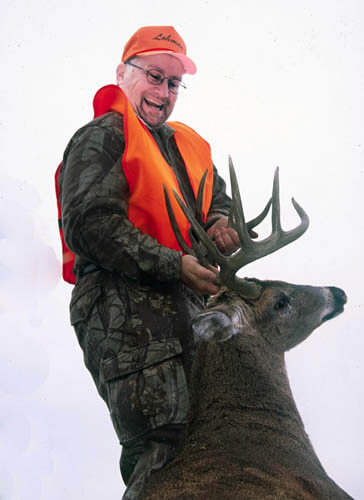 You’ll learn more deer-hunting information and tips from hunters in John E. Phillips’ Kindle, CreateSpace and Audible books. Go to https://johninthewild.com/books/#deer to purchase and download to your Kindle, and/or download a Kindle app for your iPad, SmartPhone or computer. You also can go to Nook Books at www.barnesandnoble.com to buy. Also you can download free books by going to https://johninthewild.com/free-books.
You’ll learn more deer-hunting information and tips from hunters in John E. Phillips’ Kindle, CreateSpace and Audible books. Go to https://johninthewild.com/books/#deer to purchase and download to your Kindle, and/or download a Kindle app for your iPad, SmartPhone or computer. You also can go to Nook Books at www.barnesandnoble.com to buy. Also you can download free books by going to https://johninthewild.com/free-books.

